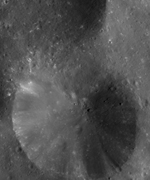
Image credit: NASA/JPL/Space Science Institute
This eye-popping high-resolution image of Phoebe’s pitted surface taken very near closest approach shows a 13-kilometer (8-mile) diameter crater with a debris-covered floor. Part of another crater of similar size is visible at left, as is part of a larger crater at top and many scattered smaller craters. The radial streaks in the crater are due to downslope movements of loose fragments from impact ejecta. Also seen are boulders ranging from about 50 to 300 meters (160 to 990 feet) in diameter. The building-sized rocks may have been excavated by large impacts, perhaps from some other region of Phoebe rather than the craters seen here. There is no visible evidence for layering of ice and regolith or a hardened crust in this region, as on other parts of this moon.
Some of the relatively bright spots are from small impacts that excavated bright material from beneath the dark surface. Images like this provide information about impact and regolith processes on Phoebe.
This image was obtained at a phase, or Sun-Phoebe-spacecraft, angle of 78 degrees, and from a distance of 11,918 kilometers (7,407 miles). The image scale is approximately 18.5 meters (60.5 feet) per pixel. The illumination is from the right. No enhancement was performed on this image.
The Cassini-Huygens mission is a cooperative project of NASA, the European Space Agency and the Italian Space Agency. The Jet Propulsion Laboratory, a division of the California Institute of Technology in Pasadena, manages the Cassini-Huygens mission for NASA’s Office of Space Science, Washington, D.C. The imaging team is based at the Space Science Institute, Boulder, Colorado.
For more information about the Cassini-Huygens mission, visit http://saturn.jpl.nasa.gov and the Cassini imaging team home page, http://ciclops.org.
Original Source: CICLOPS News Release
